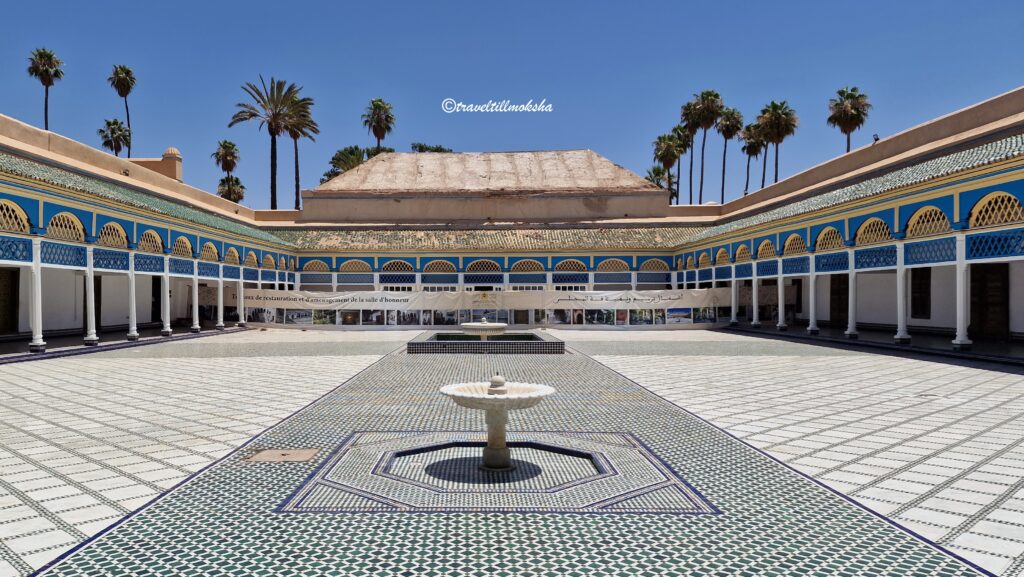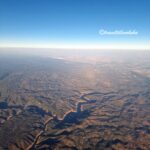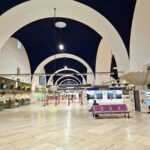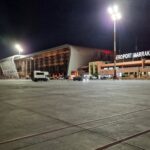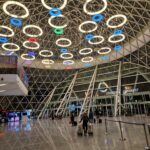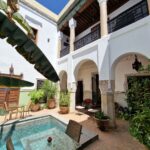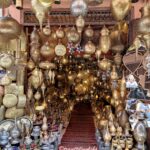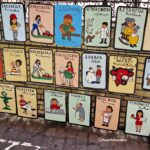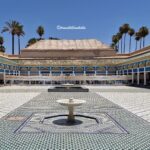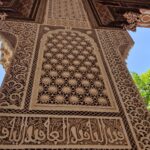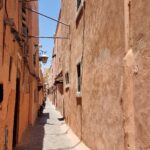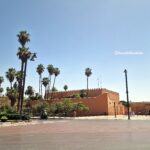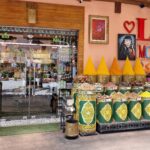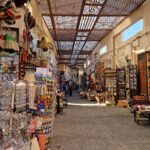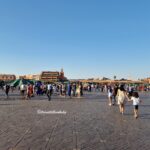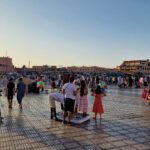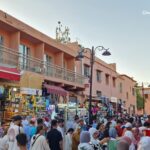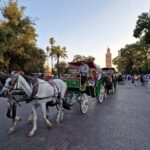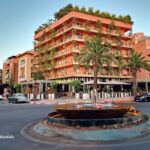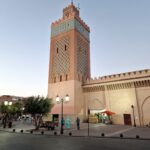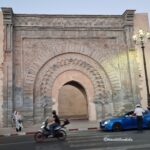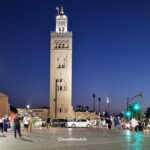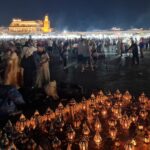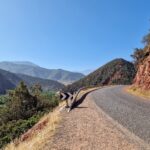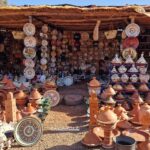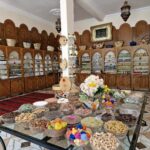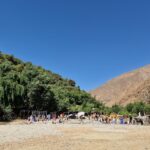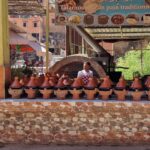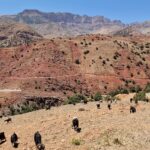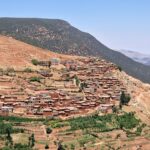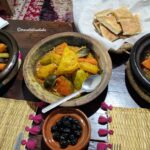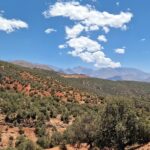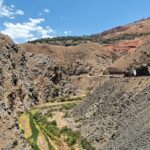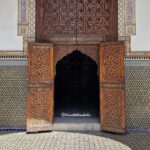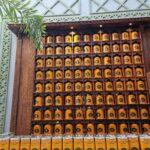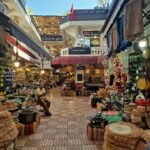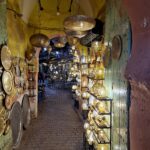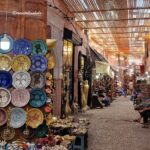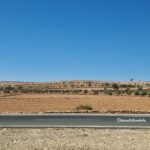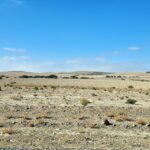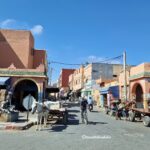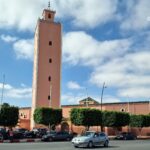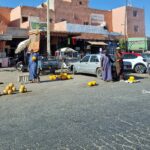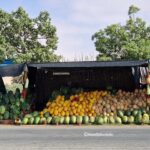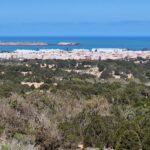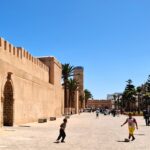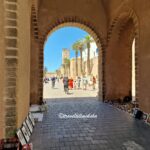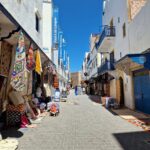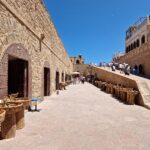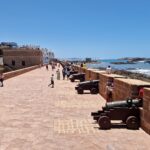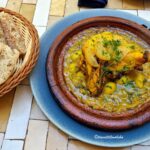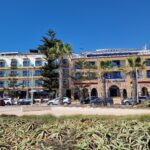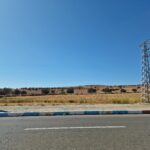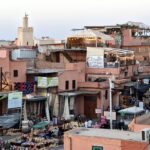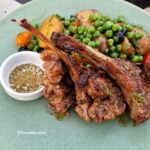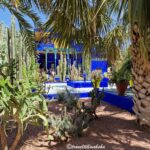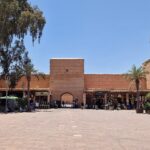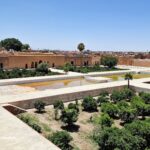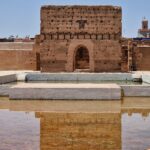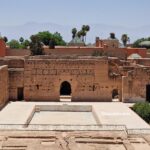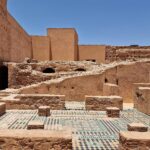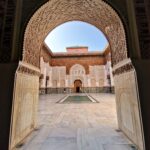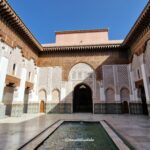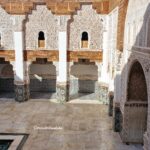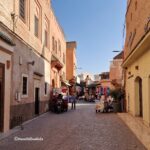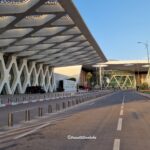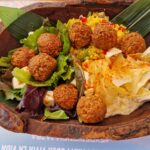Itinerary Summary:
Travel Time: early July 2023 (was very hot! check avg. temperatures by month here)
Day 0: Travel from Nuremberg to Marrakesh via Sevilla
Day 1: Explore the Medina of Marrakesh
Day 2: High Atlas – Five Valley Tour and stroll around the Medina in the evening
Day 3: Essaouira Day Tour
Day 4: Remaining sights of Marrakesh before flying back to Nuremberg via Málaga
Travel Tip: Euro notes are accepted at all shops – expect change to be paid in Moroccan Dirhams though 😉
Day 0:
Our first adventure to Africa and Morocco began with a Ryanair flight from Nuremberg to Marrakesh, but not before we enjoyed the spectacular landscape of Andalusia, as we touched down in Sevilla for a 3-hour layover. We had no such luck with the Moroccan landscape however, as we arrived in Marrakesh well after midnight. Our hotel, the Riad Azzar in Derb Dabachi, had arranged for our pickup, and we were soon in the heart of the old Medina of Marrakesh, looking forward to the next four days in this North African gem.
Day 1:
With the sun setting the sky ablaze in the peak heat of early July, we embarked on our exploration of the Medina of Marrakesh!
1) Souk Semmarine: Located near Riad Azzar, the heartbeat of Marrakesh’s Medina, it presented for us the perfect visualization of a medieval era souk or bazaar – a bustling, vibrant marketplace embodying the city’s rich culture, heritage, and craftsmanship. We were truly charmed by the diversity of wares, colours, and fragrances.
2) Bahia Palace: Winding through Souk Semmarine, we arrived at this epitome of Moroccan Grandeur. This 19th century architectural masterpiece hides within it a world of stunning mosaics, graceful courtyards, and lush gardens, and justifies its name which means “brilliance”. Should be on the top of the list for anyone visiting Marrakesh!
3) Spice Souk, Jewish Quarter, and Tinsmiths Square: A harmonious blend of cultures, this quarter is located next to the Bahia Palace in the heart of Marrakesh’s bustling Medina. Walking along the labyrinthine lanes, we couldn’t help but be drawn by the symphony of fragrances – from saffron to Ras el hanout! Narrow alleys leading to Tinsmith’s square were lined with stalls stacked with vibrant spices, dried fruits, and aromatic herbs, while the local merchants tried everything, from invoking Shah Rukh Khan to offering free tasting sessions, to get us to buy their wares – we had to have our bargaining skills at top notch here!
4) Jemaa el-Fnaa: Each city has either an official or an unofficial centre, and the Jemaa el-Fnaa is Marrakesh’s throbbing heartbeat. Even though, we crossed the square for the first time in daylight when we headed back to our Riad from the Spice Souk, the enchantment and energy of the square ensured that we were back multiple times during our stay to experience the mesmerizing kaleidoscope of Moroccan culture. From seeing fruit vendors as the primary occupants at dawn, to being swarmed by tourists and small mobile vendors during the day, to listening to snake charmers and enjoying snacks at the bustling food stalls in the evening, to joining families strolling around late at night enjoying ice-cream and sweets, each visit to Jemaa el-Fnaa presented to us a different and interesting perspective on Marrakesh’s varied shades and identities.
5) Horse Carriage Ride through Marrakesh: Our final activity of the day was to hop-on to a horse-drawn carriage that whisked us around the city at sunset, past the grand and historic Koutoubia Mosque, through the upscale Hivernage district, along the Promenade of Avenue Mohammed VI, and into the ancient Kasbah district. We caught glimpses of the impressive Agnaou gate and the Royal Palace, before circling back to the bustling Djemaa el Fna. This is an activity that we would highly recommend, as you get an overview of the hues of Marrakesh – from medieval and working-class neighbourhoods to modern and luxurious villas and palaces.
We ended our first day with a leisurely walk back to our Riad, our senses awakened and eager for more!
Food haunts of the day: Mandala Society near Bahia Palace and Souk Semmarine and the Fine? Mama off Jemaa el-Fnaa – both very avg. restaurants and not recommended. Orange Juice at Aqua at Jemaa El-Fnaa.
Day 2:
After an early morning breakfast of yoghurt, fruits, and local bread at the Riad Azzar, we were off to explore a different side of Morocco – a tour of the five valleys of the High Atlas Mountains!
1) Ourika Valley: The high Atlas Mountains were barely an hour’s drive away from Marrakesh, and the dramatic beauty of the countryside couldn’t have been more different from the urban landscape of the city. Our first stop was at a local handicrafts pop-up store by the highway and the Ourika River, where we marvelled at and bought some traditional Berber pottery. Next, we paused at a local women’s cooperative, where we sampled the different ware produced from Argan Oil, before stopping at Sti/ Setti Fatma for views of the famous Ourika Valley – we couldn’t hike to the waterfalls due to lack of proper footwear, so don’t forget your sneakers!
2) Oukaimden and Sidi Fares Valleys: Meandering roads took us onward from Ourika to the valleys of Oukaimden and Sidi Fares. Each of these valleys was different in-terms of foliage as well as surprisingly, the colour of the soil. At Sidi Fares, we had the best experience of our trip when we stopped for lunch at a local Berber family home. Both the hospitality and the food – a feast of traditional tagines (chicken and vegetarian) left an indelible mark on our hearts.
3) Mount Toubkal, and Asni and Tahnaout Valleys: Post-lunch we continued our way to the Asni Valley, where we made a stop for a glimpse of Mount Toubkal, North Africa’s highest peak, before driving past the Tahnaout Valley and its meandering river and returning to Marrakesh around 4pm.
4) Dar El Bacha Museum and Cafe: Upon returning to Marrakesh, we decided not to return early to our Riad, and rather to soak in further the history and culture of Marrakesh, which is why we stepped into the Dar El Bacha Museum. More importantly, we were able to also sample some amazing coffees and cakes from across the globe at the adjoining Bacha Cafe – a true Marrakesh landmark!
5) Stroll through the Souks: Refreshed with a healthy dose of sugar and caffeine, we decided to explore the different souks on our way back to Riad Azzar. Souks Cherifia, Haddadine, Cheratine, Talaa, Souafine, and Zrabi were amongst the few that we were able to explore. Each alleyway proved to be a treasure trove of trinkets, textiles, luminaires, and leather goods, amongst others, and the vibrant colours of these markets added a perfect final touch to our unforgettable day!
Food haunts of the day: Berber Home Tagine at Said Reda, Sidi Fares, Bacha Coffee at Dar El Bacha, Marrakesh, and Nomad near Souk Semmarine.
Day 3:
Another early morning breakfast of Msemmen, honey, fruits, and mint tea, preceded our departure for the coastal town of Essaouira – a good 3-hour drive through the rural, often barren and rocky, countryside of central/western Morocco.
1) Glimpse into rural Morocco: Driving out of Marrakesh and into the countryside, our journey took us through charming hamlets, where we encountered families riding alongside us in donkey-pulled carts and local men in flowing cotton Dejellaba‘s selling some of the largest melons and watermelons we had ever seen. It was a chance to glimpse the simple yet vibrant lives of rural Morocco, a far cry from the hustle and bustle of Marrakesh. We also made a short-stop at another Argan Oil cooperative, where we were once again welcomed with a traditional Moroccan ululation, oddly similar to our Bengali ones, a reminder that cultures across the world are often connected in the strangest of ways.
2) Essaouira – Old Fortress, Medina, and Seafront Promenade: We reached the enchanting coastal town of Essaouira around noon. A unique city which blends in North African, Arabic, and Mediterranean cultures in its architecture, food, and joie de vivre. Our cab dropped us off near the Bab El Mechouar near the Place Moulay Hassan. From there, we started to explore the labyrinthine streets of the Medina, a UNESCO World Heritage Site, making stops at the numerous shops selling traditional jewellery, bags, and other souvenirs, before walking up the ramp to the Portuguese built majestic Old Fortress and its City Walls, standing stoically against the waves of the Atlantic. We then retraced our steps through the Medina, exiting the old town through the Bab Sbaa and strolling along the promenade to Essaouira beach, before finally heading back to Marrakesh from outside the Essaouira port at around 5:30 pm.
To sum-up, our day trip to Essaouira had been a blend of culture, architecture, natural beauty, and history. The town’s rich heritage and the rural charms of the journey left us with cherished memories of Morocco’s diverse landscapes and warm-hearted people. The only downside, which we observed not just in Essaouira but also in parts of Marrakesh, seemed to be a lingering smell of urine in many of the old monuments, especially in nooks and shaded niches, something which the local authorities may want to address.
Food haunts of the day: Riad Al Madina in the Medina of Essaouira and La Coupole Cafe opposite Essaouira Beach.
Day 4:
Our objective for final day of the trip was to explore some of the remaining landmarks and hidden gems of Marrakesh, blending in as best as possible the modern and historic, without stretching ourselves physically, as the preceding two days had been quite hectic, exacerbated especially by the hot July sun!
1) Jardin Majorelle: Our day began with a cab ride to the iconic Jardin Majorelle. This garden was once owned by the French designers Yves Saint Laurent and Pierre Bergé. With its iconic “Majorelle Blue walled” mansion and lush greenery, it is a serene oasis in the heart of the city. We unfortunately, did not find it as impressive as should have been warranted by the steep entry price of 15 euros!
2) Al Badi Palace: Slightly disappointed, we took a cab ride back to the Medina, more specifically the historic Al Badi Palace. Its ancient 16th century walls and crumbling ruins, home to a few families of storks, encapsulate the vast courtyards and intricate chambers that hark back to the palace’s brilliant/ wonderous past, which help epitomize its name.
3) Souks of Marrakesh – one last time: Retracing our steps back to Riad Azzar for an afternoon siesta, allowed us to savour once again the vibrant colours and bustling energy of the souks, the very essence of Marrakesh that had become familiar and comforting over the last few days.
4) Ibn Youssef Madrasa/ School: Having rested, we headed to our final stop of the day and a true architectural gem – the Ibn Youssef School/ Ben Youssef Madrasa. Once the largest Islamic College in North Africa, its beautiful architecture, exemplified in its geometrically perfect murals, niches, galleries, and courtyards, is a testament to the country’s rich cultural heritage. We certainly seemed to have saved the best for last!
As the sun set over Marrakesh, so did the curtains on our trip. Driving to the airport, to catch a late-night flight home via Malaga, we reflected on our whirlwind four-day journey that had transported us from the heart of Europe to the enchanting allure of Morocco. The memories of Marrakesh’s bustling markets, the tranquil beauty of the Atlas Mountains, and the coastal charm of Essaouira will forever remain etched in our hearts, inspiring future adventures and hopefully drawing us back to the magical kingdom of Morocco.
Food haunts of the day: Msemmen from a local stall in the Medina, late lunch at Bigua Cafe, near Ibn Youssef School and snacks at La Palapa Beach Jazba in Málaga.

